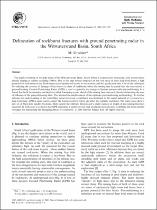 ResearchSpace
ResearchSpace
Delineation of rockburst fractures with ground penetrating radar in the Witwatersrand Basin, South Africa
JavaScript is disabled for your browser. Some features of this site may not work without it.
- ResearchSpace
- →
- Research Publications/Outputs
- →
- Journal Articles
- →
- View Item
| dc.contributor.author |
Grodner, M

|
en_US |
| dc.date.accessioned | 2007-02-08T07:59:46Z | en_US |
| dc.date.accessioned | 2007-06-07T10:06:19Z | |
| dc.date.available | 2007-02-08T07:59:46Z | en_US |
| dc.date.available | 2007-06-07T10:06:19Z | |
| dc.date.issued | 2001-09 | en_US |
| dc.identifier.citation | Grodner, M. 2001. Delineation of rockburst fractures with ground penetrating radar in the Witwatersrand Basin, South Africa. International Journal of Rock Mechanics and Mining Sciences, vol 38(6), pp 885-891 | en_US |
| dc.identifier.issn | 1365-1609 | en_US |
| dc.identifier.uri | http://hdl.handle.net/10204/1661 | en_US |
| dc.identifier.uri | http://hdl.handle.net/10204/1661 | |
| dc.description.abstract | The depth of mining in the gold mines of the Witwatersrand Basin, South Africa is continuously increasing, with several mines already stopping at depths exceeding 3500m. Due to the high stresses imposed on the rock mass in these deep level mines, a high potential for rockbursts exists. Rockbursts cause injuries and deaths to the workers and lost production time. One of the techniques for reducing the severity of damage of face-bursts (a class of rockbursts where the mining face is ejected into the excavation) is preconditioning. Ground Penetrating Radar (GPR) is used to quantify the change in fracture pattern with preconditioning. It is found that both the intensity and depth to which fracturing occurs ahead of the mining face increased, thereby delineating the area of influence of the preconditioning blast, This allowed the establishment of the optimum preconditioning methodology. To further enhance the understanding of the controlling factors involved, a rockburst was simulated in the tunnel sidewall of a crosscut in a deep level mine. GPR is again used to depict the fracture pattern before and after the synthetic rockburst. The radar scans show a new set of blast-hole parallel fractures, whilst nearer the sidewall, dilation and a slight increase in length of pre-existing fractures occurred. In both cases it is shown that GPR represents a useful tool for rock mechanics practitioners in defining the most suitable strategies for minimizing the damaging effects of rockbursts | en_US |
| dc.format.extent | 717118 bytes | en_US |
| dc.format.mimetype | application/pdf | en_US |
| dc.language.iso | en | en_US |
| dc.publisher | Pergamon-Elsevier Science Ltd | en_US |
| dc.rights | Copyright: 2001 Elsevier Science Ltd | en_US |
| dc.subject | Rock bursts | en_US |
| dc.subject | Mining | en_US |
| dc.subject | Preconditioning blast holes | en_US |
| dc.subject | Ground penetrating radar | en_US |
| dc.subject | GPR | en_US |
| dc.subject | Engineering | en_US |
| dc.title | Delineation of rockburst fractures with ground penetrating radar in the Witwatersrand Basin, South Africa | en_US |
| dc.type | Article | en_US |
| dc.identifier.apacitation | Grodner, M. (2001). Delineation of rockburst fractures with ground penetrating radar in the Witwatersrand Basin, South Africa. http://hdl.handle.net/10204/1661 | en_ZA |
| dc.identifier.chicagocitation | Grodner, M "Delineation of rockburst fractures with ground penetrating radar in the Witwatersrand Basin, South Africa." (2001) http://hdl.handle.net/10204/1661 | en_ZA |
| dc.identifier.vancouvercitation | Grodner M. Delineation of rockburst fractures with ground penetrating radar in the Witwatersrand Basin, South Africa. 2001; http://hdl.handle.net/10204/1661. | en_ZA |
| dc.identifier.ris | TY - Article AU - Grodner, M AB - The depth of mining in the gold mines of the Witwatersrand Basin, South Africa is continuously increasing, with several mines already stopping at depths exceeding 3500m. Due to the high stresses imposed on the rock mass in these deep level mines, a high potential for rockbursts exists. Rockbursts cause injuries and deaths to the workers and lost production time. One of the techniques for reducing the severity of damage of face-bursts (a class of rockbursts where the mining face is ejected into the excavation) is preconditioning. Ground Penetrating Radar (GPR) is used to quantify the change in fracture pattern with preconditioning. It is found that both the intensity and depth to which fracturing occurs ahead of the mining face increased, thereby delineating the area of influence of the preconditioning blast, This allowed the establishment of the optimum preconditioning methodology. To further enhance the understanding of the controlling factors involved, a rockburst was simulated in the tunnel sidewall of a crosscut in a deep level mine. GPR is again used to depict the fracture pattern before and after the synthetic rockburst. The radar scans show a new set of blast-hole parallel fractures, whilst nearer the sidewall, dilation and a slight increase in length of pre-existing fractures occurred. In both cases it is shown that GPR represents a useful tool for rock mechanics practitioners in defining the most suitable strategies for minimizing the damaging effects of rockbursts DA - 2001-09 DB - ResearchSpace DP - CSIR KW - Rock bursts KW - Mining KW - Preconditioning blast holes KW - Ground penetrating radar KW - GPR KW - Engineering LK - https://researchspace.csir.co.za PY - 2001 SM - 1365-1609 T1 - Delineation of rockburst fractures with ground penetrating radar in the Witwatersrand Basin, South Africa TI - Delineation of rockburst fractures with ground penetrating radar in the Witwatersrand Basin, South Africa UR - http://hdl.handle.net/10204/1661 ER - | en_ZA |





